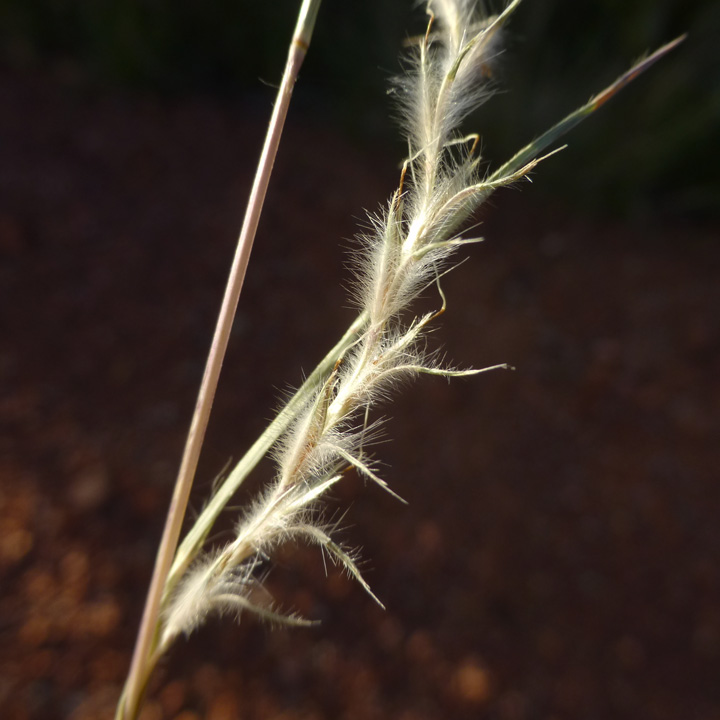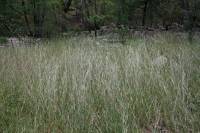Plants cespitose. Culms 40-120 cm, erect, not rooting or branching at the lower nodes, glabrous. Sheaths glabrous, rounded; ligules 0.7-2 mm; blades 7-20 cm long, 1-6 mm wide, usually with long, papillose-based hairs basally, glabrous elsewhere, sometimes scabrous, without a longitudinal stripe of white, spongy tissue. Peduncles 4-6 cm; rames 4-15 cm, not open, usually almost fully exserted at maturity; internodes 4-6 mm, straight, from mostly glabrous with a tuft of hairs at the base to densely hirsute all over. Sessile spikelets 5-9 mm; calluses 0.5-1 mm, hairs to 2 mm; lower glumes glabrous or densely pubescent; upper lemmas cleft for (2/3)3/4-7/8 of their length; awns 15-25 mm. Pedicels 3-6 mm long, 0.3-0.5 mm wide at the base, gradually widening to about 0.6-0.8 mm at the top, straight. Pedicellate spikelets 3-5 mm, usually evidently shorter than the sessile spikelets, sterile or staminate, awned, awns 0.3-6 mm.
Schizachyrium sanguineum extends from the southern United States to Chile, Paraguay, and Uruguay.
Common Name: crimson bluestem
Duration: Perennial
Nativity: Native
Lifeform: Graminoid
General: Tufted perennial with stems 40-120 cm, erect, glaucous, branching at the upper nodes.
Vegetative: Sheaths glabrous, rounded; ligule membranous, 1-2 mm long; blades 10-20 cm long and 1-5 mm wide, glabrous or scabrous, with long, papillose hairs near the base of the blade.
Inflorescence: Terminal inflorescences, each consisting of a single pedunculate rame with appressed sessile-pedicillate spikelet pairs; rames 4-10 cm long, fully exserted from the uppermost leaf sheath at maturity; rame internodes 4-6 mm, straight, mostly glabrous with a tuft of hairs at the base or densely hirsute all over. Pedicellate spikelets 3-5 mm, sterile or staminate, usually evidently shorter than the sessile spikelets, with awns 0.3-5 mm; pedicels arcuate at maturity, 3-6 mm long, ciliate on both edges distally. Sessile spikelets 5-9 mm, 2-flowered, the lower floret reduced to a hyaline lemma, the upper floret bisexual; calluses 0.5-1 mm, with hairs to 2 mm; lower glumes sparsely to densey hirsute on the back, upper (fertile) lemmas deeply cleft for 3/4 to 7/8 their length, with awns 15-25 mm long.
Ecology: Found on rocky slopes to well drained soils from 4,000-5,500 ft (1219-1676 m), flowers June-October.
Distribution: Ranges from AZ to sw TX and FL; south to S. Amer.
Notes: Schizachyrium is a genus of perennial bunchgrasses with inflorescences consisting of a single branch (rame) lined with spikelets that are grouped in pairs, one spikelet sessile and fertile, the other pedicillate and sterile or staminate. The genus is distinguished from the similar and related genus Andropogon by the solitary rames; Andropogon species usually have more than one rame per inflorescence. The Schizachyriums in the southwest are incredibly similar to each other and quite difficult to tell apart using simple field-friendly traits. S. cirratum is primarily distinguished from this species by its inflorescences which appear glabrous to the naked eye ( but note that the rames and pedicels do have shorter hairs that are visible using a hand lens). In contrast, this species and congener S. scoparium have copiously hairy glumes, the tufts white, several mm long, and visible to the naked eye. This species is distinguished from S. scoparium by having appressed spikelets, while S. scoparium often has a more open inflorescence, with the spikelets diverging from the central axis at maturity. The key character separating this species from S. scoparium is the upper lemmas of the sessile spikelets being cleft for most of their length in this species, while only cleft for half their length on S. scoparium. Also, this species has purple stigmas and yellow anthers, while S. cirratum has purple stigmas and purple anthers, and S scoparium has yellow-white stigmas and purple anthers. Use caution, however, as this trait is only reliable when the plant is in full flower. As the flowers fade, so do the colors. There are two varieties of S. sanguineum; ours are all var. hirtiflorum.
Ethnobotany: Unknown
Etymology: Schizachyrium is Greek word, meaning divided or cut chaff flower, while sanguineum means blood red.
Synonyms: None
Editor: SBuckley 2012, AHazelton 2015






